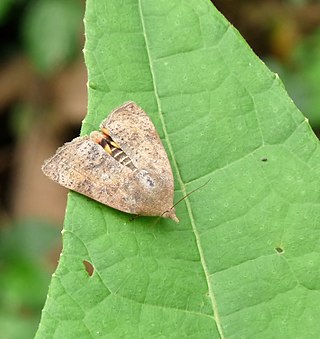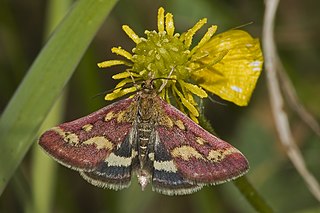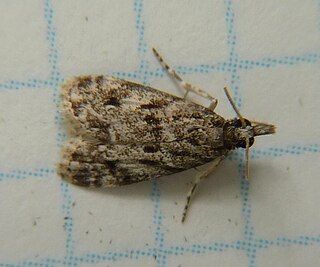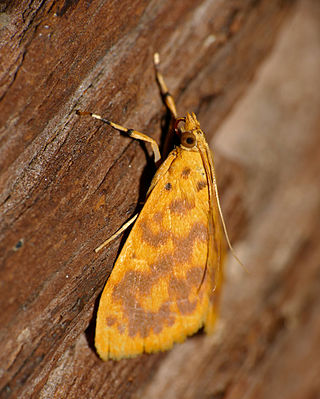
Crambidae comprises the grass moth family of lepidopterans. They are variable in appearance, with the nominal subfamily Crambinae taking up closely folded postures on grass stems where they are inconspicuous, while other subfamilies include brightly coloured and patterned insects that rest in wing-spread attitudes.

The Pyralidae, commonly called pyralid moths, snout moths or grass moths, are a family of Lepidoptera in the ditrysian superfamily Pyraloidea. In many classifications, the grass moths (Crambidae) are included in the Pyralidae as a subfamily, making the combined group one of the largest families in the Lepidoptera. The latest review by Eugene G. Munroe and Maria Alma Solis retain the Crambidae as a full family of Pyraloidea.

The Pyraloidea are a moth superfamily containing about 16,000 described species worldwide, and probably at least as many more remain to be described. They are generally fairly small moths, and as such, they have been traditionally associated with the paraphyletic Microlepidoptera.

Hyblaeidae are the "teak moths", a family of insects in the Lepidopteran order. The two genera with about 18 species make up one of the two families of the Hyblaeoidea superfamily, which in the past has been included in the Pyraloidea. Recent phylogenetic studies find varying relationships of Hyblaeoidea among Ditrysian Lepidoptera: Mutanen et al. (2010) find the superfamily to group either with Pyraloidea, or – more often – with Thyridoidea or butterflies. The results of Wahlberg et al. (2013) and Heikilä et al. (2015) indicate a sister-group relationship with Pyraloidea.

Spilomelinae is a very species-rich subfamily of the lepidopteran family Crambidae, the crambid snout moths. With 4,135 described species in 344 genera worldwide, it is the most speciose group among pyraloids.

Cataclysta lemnata, the small china-mark, is a moth species of the family Crambidae. It is found in Europe, Morocco and Iran.

The Obtectomera is a clade of macro-moths and butterflies, comprising over 100,000 species in at least 12 superfamilies.

Leechia is a genus of moths of the family Crambidae.
Neargyractis is a genus of moths of the family Crambidae.

Polygrammodes is a genus of moths of the family Crambidae.

Pyralis manihotalis is a moth of the family Pyralidae described by Achille Guenée in 1854.

Scoparia basalis, the many-spotted scoparia moth, is a moth of the family Crambidae. It is found in North America, including Arkansas, British Columbia, Georgia, Maine, Massachusetts, New Jersey, Oklahoma, Tennessee, Virginia and Washington.

The Galleriinae are a subfamily of snout moths and occur essentially worldwide, in some cases aided by involuntary introduction by humans. This subfamily includes the wax moths, whose caterpillars (waxworms) are bred on a commercial scale as food for pets and as fishing bait; in the wild, these and other species of Galleriinae may also be harmful to humans as pests.

Pioneabathra is a genus of moths of the family Crambidae. It contains only one species, Pioneabathra olesialis, which is found on the Comoros and the Seychelles and in Mali, the Republic of Congo, the Democratic Republic of Congo, Mozambique, Yemen (Socotra), Zambia, India, Sri Lanka and Australia.
Africella is a genus of snout moths. It was described by George Hampson in 1930 and contains the species Africella micraeola. It is found in Ghana.
Udea exalbalis is a species of moth in the family Crambidae. It is found in Kazakhstan and Russia, where it has been recorded from the Tula region.

Glaphyriinae is a subfamily of the lepidopteran family Crambidae. It was described by William Trowbridge Merrifield Forbes in 1923. The subfamily currently comprises 509 species in 75 genera.
Loxocrambus canellus is a moth in the family Crambidae. It was described by William Trowbridge Merrifield Forbes in 1920. It is found in North America, where it has been recorded from Florida, Mississippi and Texas.

Patania iopasalis is a species of moth in the family Crambidae. It was described by Francis Walker in 1859. It is found in Myanmar, India, Papua New Guinea Thailand, Sri Lanka, Borneo in Indonesia, Taiwan, China and Philippines.
Syllepte coelivitta is a moth in the family Crambidae. It was described by Francis Walker in 1866. It is found in Brazil, Suriname, Mexico and Panama.














